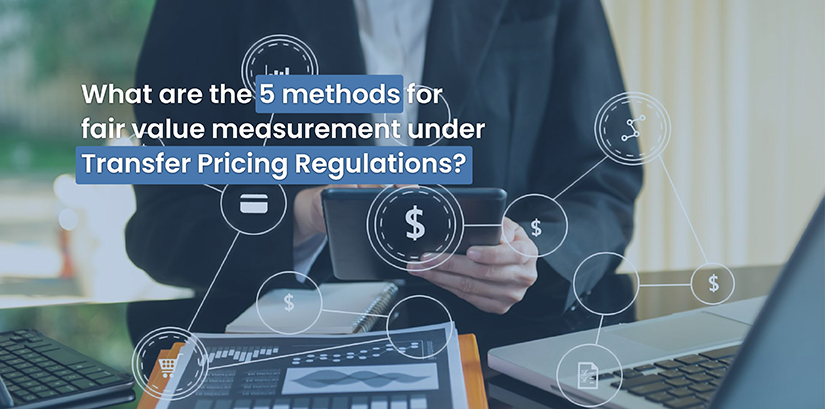What are the 5 methods for fair value measurement under Transfer Pricing Regulations?
- October 25, 2023
- Posted by: admin
- Category: Transfer Pricing

The United Arab Emirates (UAE), has established comprehensive Transfer Pricing Regulations to ensure fair value measurement in transactions between related parties. Transfer pricing is a strategy that companies use to set the price of goods and services for transactions between their affiliated organizations. The Organization for Economic Cooperation and Development (OECD) regulates this practice and outlines five primary transfer pricing methods. These methods aim to make sure that the transfer pricing is accurate and fair for transactions between related parties. Let’s see each of these methodologies to gain a comprehensive understanding.
Standard Transfer Pricing Methods
These are the five primary transfer pricing methods in UAE, the OECD outlines
- Comparable Uncontrolled Price (CUP) Method
- Resale Price Method
- Cost Plus Method
- Transactional Net Margin Method
- Profit Split Method
-
Comparable Uncontrolled Price (CUP) Method
The Comparable Uncontrolled Price (CUP) method, regarded as one of the most direct techniques, involves benchmarking the price of a product or service in a controlled transaction to the price of the same product or service in an uncontrolled transaction. In UAE’s Transfer Pricing Regulations, this method serves as a vital tool for businesses engaged in transactions with affiliated entities, allowing them to ensure that the prices charged or paid in these transactions align with market rates.
-
Resale Price Method (RPM)
This method involves setting the price of a product or service based on the resale price at which an independent enterprise resells the product or service in an uncontrolled transaction. By applying the RPM, businesses in the UAE can determine the appropriate resale price margins in transactions with related parties, thus maintaining fairness and transparency in their commercial dealings.
-
Cost Plus Method (CPM)
The Cost Plus Method (CPM) is yet another essential approach integrated into the UAE’s Transfer Pricing Regulations. This method involves setting the price of a product or service by adding an appropriate markup to the cost of production. In the UAE’s business landscape, the CPM serves as a mechanism for companies to ascertain whether the costs incurred in transactions with related entities, coupled with a reasonable profit margin, conform to market standards and industry norms.
-
Transactional Net Margin Method (TNMM)
The Transactional Net Margin Method (TNMM) plays a pivotal role in the UAE’s Transfer Pricing Regulations. This method involves the comparison of the net profit margin derived from a controlled transaction with the net profit margin realized in comparable uncontrolled transactions. By employing the TNMM, businesses operating in the UAE can evaluate the profitability of their transactions with related entities, thereby protecting against any potential misalignment with market benchmarks and industry norms.
-
Profit Split Method (PSM)
This method involves the division of profits generated from a controlled transaction between related parties based on the relative contributions of each party to the transaction. By implementing the PSM, businesses in the UAE can ensure equitable distribution of profits in complex transactions, fostering a fair and balanced approach to value measurement.
Key Considerations in Fair Value Measurement
Several other factors demand attention, such as the nature of the transaction, market conditions, and the reliability of data. Consider these elements to ensure a comprehensive evaluation process.
Ensuring Compliance with Transfer Pricing Regulations
To operate seamlessly within the UAE’s regulatory framework, businesses must prioritize adherence to transfer pricing regulations. It is essential to maintain meticulous records and conduct regular internal audits to ensure compliance and avoid legal outcomes.
Fair Value Measurement Impact On Business Strategies
Effective fair value measurement directly impacts a company’s financial strategies, influencing decision-making processes, investment opportunities in UAE, and overall business growth. Adhering to these methods fosters trust and credibility, enhancing business relationships both locally and globally.
Seek Professional Advisors
Given the intricacies of fair value measurement and transfer pricing regulations, seeking guidance from experienced professional advisors can prove invaluable. BRISK advisors provide clarity and ensure adherence to the regulatory framework, protecting businesses from potential pitfalls.
We’ll Help You Navigate Transfer Pricing
If you’re finding it challenging to choose the perfect transfer pricing method among the five, we’ve got you covered. Our team of transfer pricing experts is here to provide guidance and support based on their extensive experience. Reach out to us to discover how we collaborate with tax teams to ensure the best possible financial results for your business.


